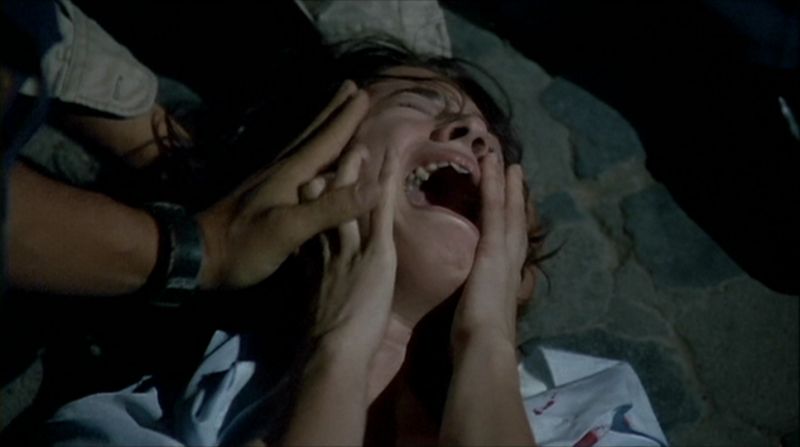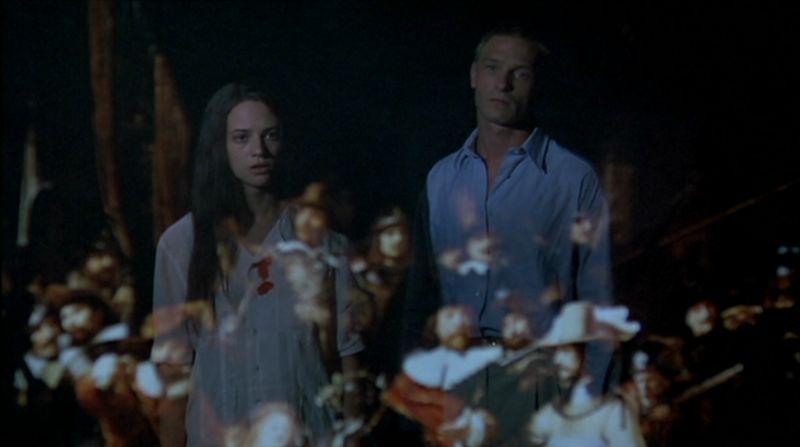

“Style over substance” is the phrase one most often hears in relation to Dario Argento’s work. Whether it’s shards of stained glass impaling helpless victims (Suspiria, 1977), bullets being shot into your eye through a peephole (Opera, 1987), or simply a sixteen year old Jennifer Connelly falling into a “flesh” pool backwards (Phenomena, 1985), Argento truly knows how to create breathtaking, horrific images that stand the test of time. The lack of so-called “substance” in his work has never bothered me because, frankly, the images or “visions” as they are - speak for themselves. Dream logic is just as important in the Argento world as it is in the Lynch world - it may not always make sense, but the bits and pieces we accumulate through our consciousness somehow makes everything feel complete, not necessarily cohesive, but organically and cosmically whole. He doesn’t need the schlock dialogue or badly dubbed lines to articulate his cinematic feelings and I’ve often wished he would do away with those aspects all together. Can you imagine a no-dialogue Argento film? With just Keith Emerson’s and/or Goblin’s music accompanying the visuals? Bad ass.

Anyway, Argento’s uninspiring, self-parodist work in the 1990’s seems to have led him back to the “oldie but goodie” territory of his 70’s and 80’s films - namely, The Three Mothers trilogy, which started in 1977 with Suspiria (the mother of sighs) and continued on into the 80’s with Inferno (the mother of darkness, 1980). He’s finally capped off the trilogy with his latest film, The Mother of Tears, starring his daughter, Asia, and his long-time, on again/off again partner and mother of Asia, Daria Nicolodi, as well as a slew of other Argento returning guests like Coralina Cataldi-Tassoni. The usual suspects are all in place for The Mother of Tears except for the director himself, as this is least “Argento” feeling Argento I’ve ever seen. Indeed, The Mother of Tears paces and parades itself like a run of the mill horror flick without any of the painterly pizzazz of the Italian horror master himself.

And while this is troublesome for the cinephile in my soul who loves to sit in a darkened theatre with her mouth hanging open during the beginning of Suspiria, I can appreciate Argento’s choice to step away from his usual aesthetic and focus on new aspects of creativity because it means he’s trying to reinvent himself. Or should I say, reinvent herself? Most (80% or so) of Argento’s flicks feature a central (virginal) female protagonist who acts as a JV gumshoe in solving a murder mystery, a mystery usually involving a murderer who kills young, slightly “immoral” women in gruesome, disturbingly prolonged ways (razor blades to eyelids, glass in the face, etc). I used to consider this blatant misogyny and, in some cases, it is, (though Argento will never be as distasteful as his contemporary, Lucio Fulci), but my consideration was decidedly wavered when I learned Argento almost always uses his own hands on screen to commit the murders. Why would he do that?

It could easily be argued that Argento is merely executing the classic virgin/whore complex on film, that is, his murderers kill (or fuck, as most of the murders are hyper-sexual) the so-called slutty women in an effort to praise his virginal protagonists - the gals’ who are just too good to be caught. Too good, in fact, to wear anything but lily-white, not-too-tight frocks and generally be framed from the shoulders up. And the other girls, the dead girls, that is, show enough T&A while being sliced and diced in shredded dark clothing to open up their own strip joint. That and then there’s this quote by him:

“I like women, especially beautiful ones. If they have a good face and figure, I would much prefer to watch them being murdered than an ugly girl or man. I certainly don't have to justify myself to anyone about this. I don't care what anyone thinks or reads into it. I have often had journalists walk out of interviews when I say what I feel about this subject.”
However, Argento’s recent return to the Three Mothers territory has me questioning the director’s true intentions. In Mother of Tears, Argento places an incredible amount of importance upon well, motherhood, and the startling power of rebirth - the rebirth of the self, of the mind, and of the heart. Thinking back to all of the classic Argento films - Deep Red, Suspiria, Inferno, Phenomena, Opera, etc. - they all seem to feature direct themes to the idea of rebirth and being born again. For instance, after Jennifer Connelly falls into the “flesh pool” and gets doused in bodily, bloody ooze, the plot directly takes her to battling a child mutant in a crisp, clear lake where she emerges victoriously with her long, flowing white attire billowing at her sides.

…Is Argento trying to exorcise his demons cinematically by physically killing off his “immoral” impulses through the murder victims? Does he want to become one of his protagonists?


Much has been said about Argento using his own daughter, Asia, as the central protagonist in the latter part of his career. In the four pictures, they’ve made together - Trauma (1993), Stendhal Syndrome (1995), Phantom of the Opera (1998), and now Mother of Tears (2007), Ms. Argento is frequently the victim of brutal, grotesque rape, violence, and even acts as a fetish subject for serial killers galore. However, to inspect the arc of these four films is to understand the basis of my argument. Argento is using Asia, his own flesh and blood, a piece of himself - to explore and conquer his own demons. It’s almost as if each of the film’s Asia is in removes a layer of his torturous psyche and desires. The first two layers, Trauma and The Stendhal Syndrome, are by far the worst - seeing Argento put his own daughter in the character’s situations feels like you’re watching the rape scene in Irreversible (2002) ten times in a row. She gets so mind-fucked by the serial killers in each movie that there’s no way her characters will be able to psychologically survive after the film’s end. Phantom of the Opera, perhaps Argento’s worst film, is much less severe on Asia’s end and even treats her as somewhat of an angelic presence.

And, in Mother of Tears, Asia rises above all of her previous protagonists to become the pure heroine Argento has always aspired her/himself to be. Heck, she doesn’t even get fully naked in the film. Several other women do, unfortunately, and Argento seems to have felt the need to shamelessly point out his puritanical victory by murdering his women in even more terrifying ways than before. The most prevalent example I can think of is a woman dying at the hands of a gigantic spear stabbing her vagina. In fact, almost all of the deaths in Mother of Tears, including infant death, involve his hyper-sexual flare. Except without his stylistic talents to back him up, Argento is merely provoking disgust instead of provoking discussion, which is what I genuinely think he was trying to attain with his latest cinematic effort and failed miserably in the process.

That being said, I have high hopes that Argento’s next picture, the appropriately named Giallo (2009) will introduce new, fresh ideas to the filmmaker’s body of work and inspire audiences to reappraise their preconceived notions of Argento as an artist and appreciate him once again. We need all of the horror film auteurs we can get.







3 comments:
I haven't seen much of Argento( I've only seen two: Deep Red and Inferno)- the gore tends to be a bit much even for me. (This coming from the man who champions George Romero's zombie flicks)
However, your piece was a fascinating read. Very interesting observations here- especially the bit about him peeling away his personal demons (or something like that)
It's true that there aren't enough true horror film auteurs out there. There's Argento, Romero and then who else? You know it's bad when some critical circles would include Eli Roth in the same company as the other two I mentioned.
Fascinating piece; I appreciate any article shedding light on a director who, considering his reputation amongst horror fans is very poorly represented in publications. I agree with the previous poster about the part of Argento exorcising his demons. This is a very similar conclusion that has been drawn when discussing his films with my brothers (we're all big fans of Argento!)I have to admit that I have never felt offended by one of his films which is something I'm quite intrigued by considering the reaction his films have had in the past. I hope to explore this when I come to write my Master's thesis on him and his works, with emphasis on the representation of the both the female and the male in his works. I would very much appreciate referencing your piece if you'll allow me. I see you have put your e-mail address for such requests so hopefully I'll be e-mailing you nearer the time. Thanks for writing this!
Hey there! Thank you so much for your compliments. I love Argento as well (Phenomena and Opera are my favorites) and I really enjoy exploring his work theoretically. Like you said, not enough people are writing about him or other horror auteurs for that matter. I don't feel personally offended by his flicks either, but I do think some of his ideas are problematic. Please feel free to reference my essay. I would love to read it! Though my blog as a project is kind of defunct as of right now, I am writing for other publications and plan on analyzing Stendhal Syndrome and Scarlet Diva for my feminist film column at In Review Online (http://web.me.com/inreviewonline/inreviewonline/HOME/Entries/2009/11/4_Kinofemme_-_Introduction.html) in the near future. If you need any help or just want to chat about movies, please don't hesitate to e-mail me! Thanks again. I'm looking forward to reading your work. :-)
Post a Comment